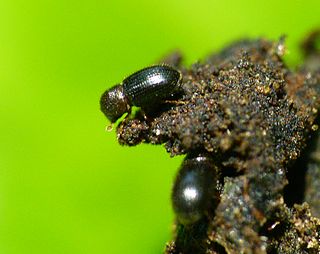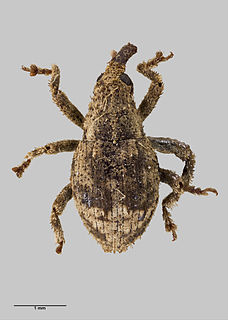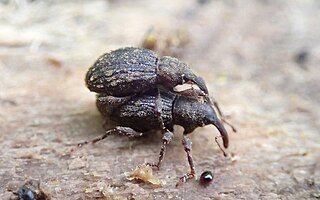Related Research Articles

The Curculionidae are the family of the "true" weevils. They are one of the largest animal families, with 6,800 genera and 83,000 species described worldwide.

The coffee borer beetle or coffee berry borer is a small beetle native to Africa. It is among the most harmful pests to coffee crops across the world where coffee is cultivated. Spanish common names of the insect include barrenador del café, gorgojo del café, and broca del café.

Naupactus is a genus of beetles in the weevil family Curculionidae, the true weevils. They are known commonly as whitefringed beetles. Many species of the genus are considered pests, both as larvae and as adults. The genus is native to the Americas, where it is distributed from Mexico to Argentina; the highest species diversity is in Brazil. Several species have been introduced to the United States and New Zealand.

Laemophloeidae, "lined flat bark beetles," is a family in the superfamily Cucujoidea characterized by predominantly dorso-ventrally compressed bodies, head and pronotal discs bordered by ridges or grooves, and inverted male genitalia. Size range of adults is 1–5 mm (0.04–0.2 in) in length. Currently, it contains 40 genera and about 450 species, and is represented on all continents except Antarctica; species richness is greatest in the tropics.

Rhynchophorus, or common name palm weevil, is a genus of beetles in the weevil family, Curculionidae. Palm weevils are major pests of various trees in the family Arecaceae throughout the tropics including: coconut, Areca catechu, species of the genus Phoenix, and Metroxylon sagu.

Ips is a genus of beetles in the family Curculionidae, the true weevils. They are bark beetles, members of the subfamily Scolytinae. Species are distributed throughout the Northern Hemisphere. Some are known as introduced species in Australia and Africa. Many species are pests of forest trees, especially pines and spruces. They are known commonly as engraver beetles, ips engraver beetles, and pine engravers.

Didymus is a genus of beetles known as weevils. The genus contains the following species:

Cionus hortulanus is a species of weevils belonging to the family Curculionidae, subfamily Curculioninae.

Lignyodes is a genus of ash seed weevils in the family Curculionidae. There are at least 18 described species in Lignyodes.
Epicaerus is a genus of broad-nosed weevils in the family Curculionidae. There are at least 11 described species in Epicaerus.

Sthereus is a genus of beetles in the family Curculionidae. There are at least 4 described species in Sthereus.
Macrorhoptus is a genus of beetles in the family Curculionidae. There are about 6 described species in Macrorhoptus.
Conophthorus is a genus of typical bark beetles in the family Curculionidae. There are about 10 described species in Conophthorus.

Baridini is a tribe of flower weevils in the family Curculionidae. There are about 16 genera and at least 40 described species in Baridini.

Hypothenemus is a genus of oriental bark beetles in the family Curculionidae. There are about 18 described species in Hypothenemus.

Phloeosinus is a genus of cedar bark beetles in the family Curculionidae. There are at least 20 described species in Phloeosinus.

Pandeleteius is a genus of broad-nosed weevils in the family Curculionidae. There are about 13 described species in Pandeleteius.
Baris rubripes is a species of flower weevil in the beetle family Curculionidae.
Baris interstitialis is a species of flower weevil in the beetle family Curculionidae. It is found in North America.
Baris monticola is a species of flower weevil in the beetle family Curculionidae. It is found in North America.
References
- ↑ G. Poinar Jr. and A. A. Legalov (2015). "First record of the genus Baris Germar, 1817 (Coleoptera: Curculionidae), in Dominican amber". Fossil Record. 18 (1): 31–35. doi: 10.5194/fr-18-31-2015 .
| This Baridinae-related article is a stub. You can help Wikipedia by expanding it. |